Comprehensive Analysis of Employee Benefits and Incentive Pay in HRM
VerifiedAdded on 2019/10/30
|10
|2152
|249
Report
AI Summary
This report provides a comprehensive overview of employee benefits and incentive pay within Human Resource Management. It explores various methods for weighing incentive pay, emphasizing the importance of rewarding quality work and establishing a strong link between employee performance and compensation. The report delves into the core legal requirements surrounding employee benefits, including social security, unemployment insurance, health insurance, and medical leave. It also highlights additional benefits such as hazard pay, paid holidays, pay raises, and vacation leave. Furthermore, the report examines the factors to be considered before implementing benefit plans, effective communication strategies to inform employees about their benefits, and the ethical risks associated with incentive-based compensation, such as executives inflating stocks and setting up performance measures that may lower work standards. The report concludes with recommendations for HR managers and organizations to ethically implement benefit measures and maintain effective communication to achieve success.
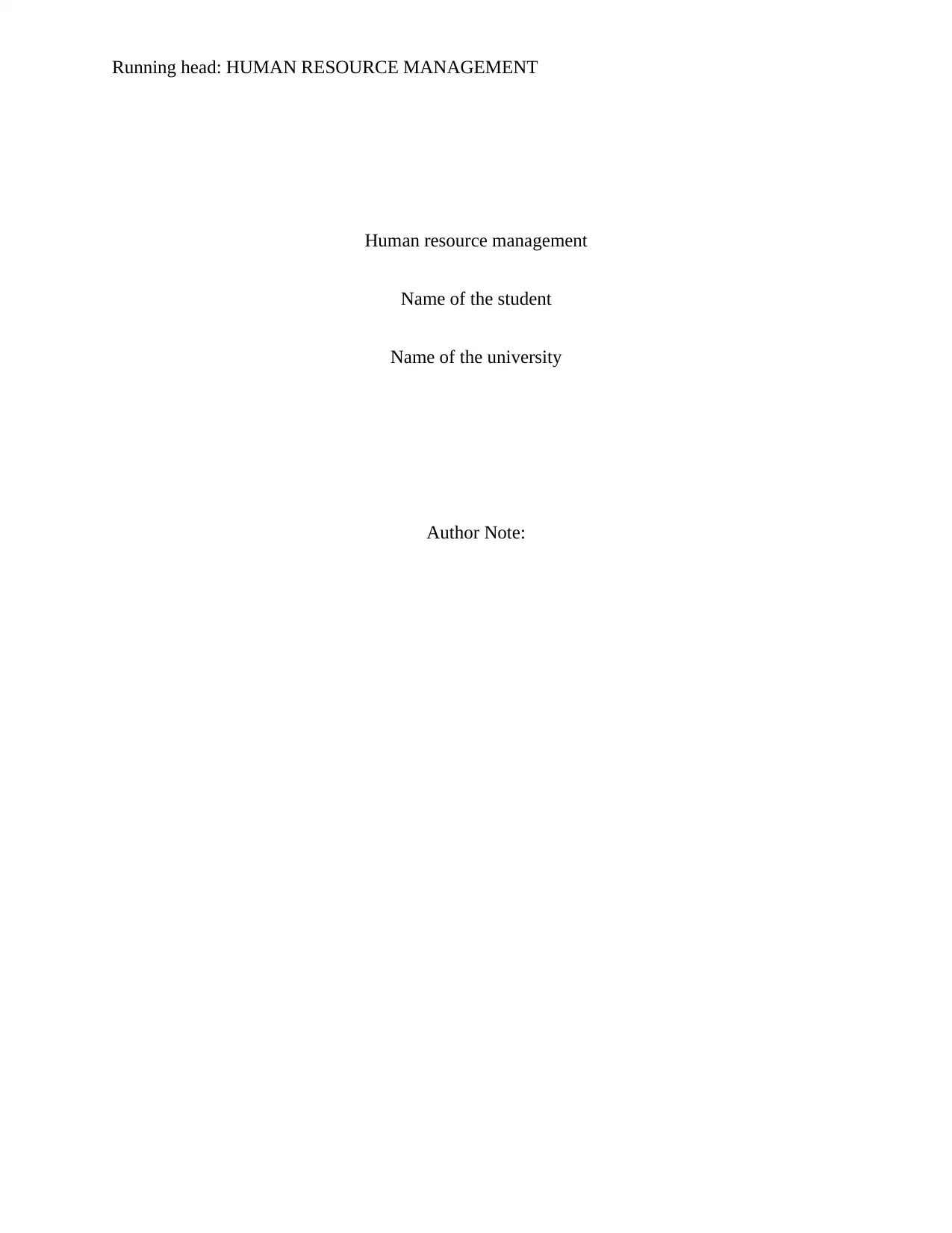
Running head: HUMAN RESOURCE MANAGEMENT
Human resource management
Name of the student
Name of the university
Author Note:
Human resource management
Name of the student
Name of the university
Author Note:
Paraphrase This Document
Need a fresh take? Get an instant paraphrase of this document with our AI Paraphraser
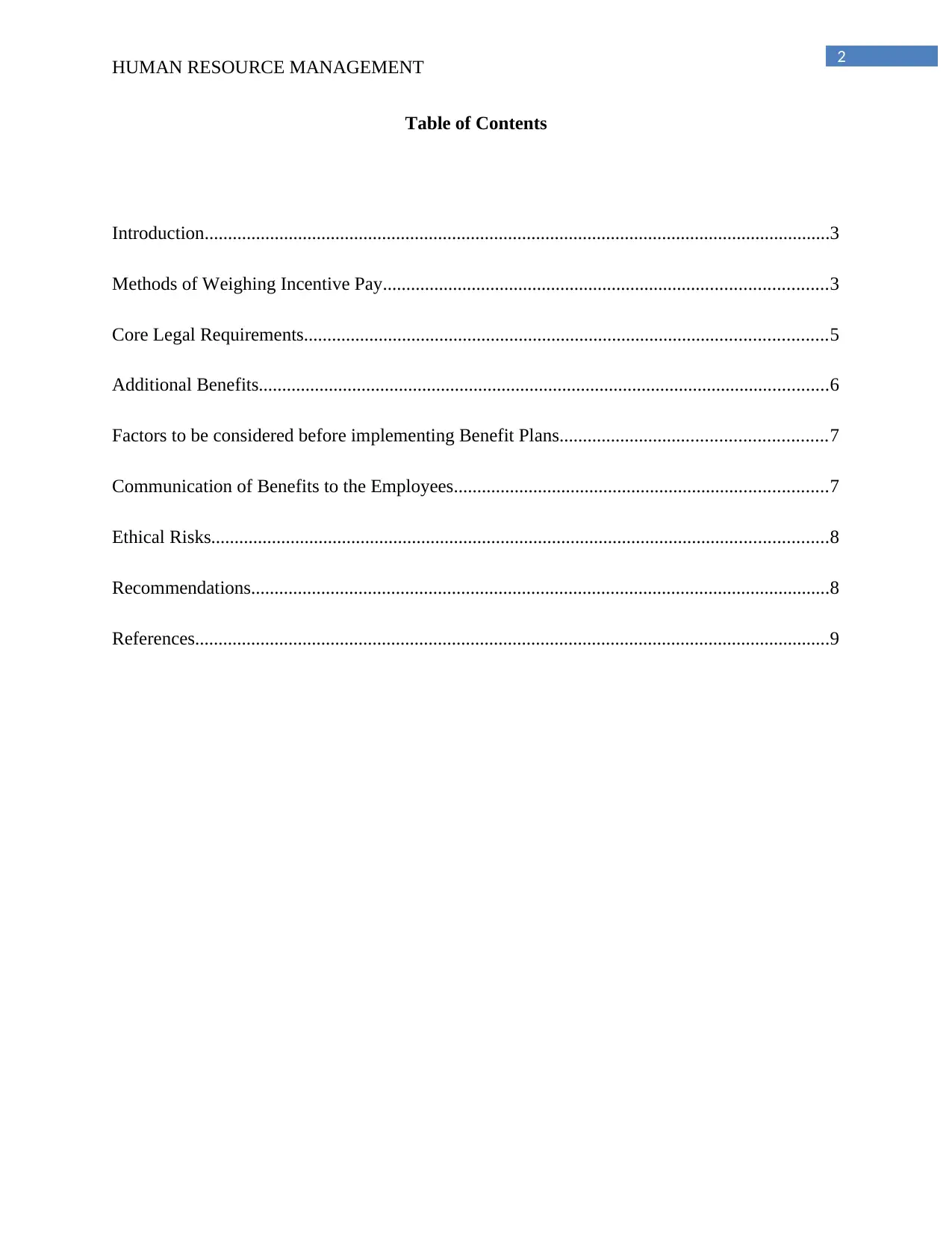
2
HUMAN RESOURCE MANAGEMENT
Table of Contents
Introduction......................................................................................................................................3
Methods of Weighing Incentive Pay...............................................................................................3
Core Legal Requirements................................................................................................................5
Additional Benefits..........................................................................................................................6
Factors to be considered before implementing Benefit Plans.........................................................7
Communication of Benefits to the Employees................................................................................7
Ethical Risks....................................................................................................................................8
Recommendations............................................................................................................................8
References........................................................................................................................................9
HUMAN RESOURCE MANAGEMENT
Table of Contents
Introduction......................................................................................................................................3
Methods of Weighing Incentive Pay...............................................................................................3
Core Legal Requirements................................................................................................................5
Additional Benefits..........................................................................................................................6
Factors to be considered before implementing Benefit Plans.........................................................7
Communication of Benefits to the Employees................................................................................7
Ethical Risks....................................................................................................................................8
Recommendations............................................................................................................................8
References........................................................................................................................................9
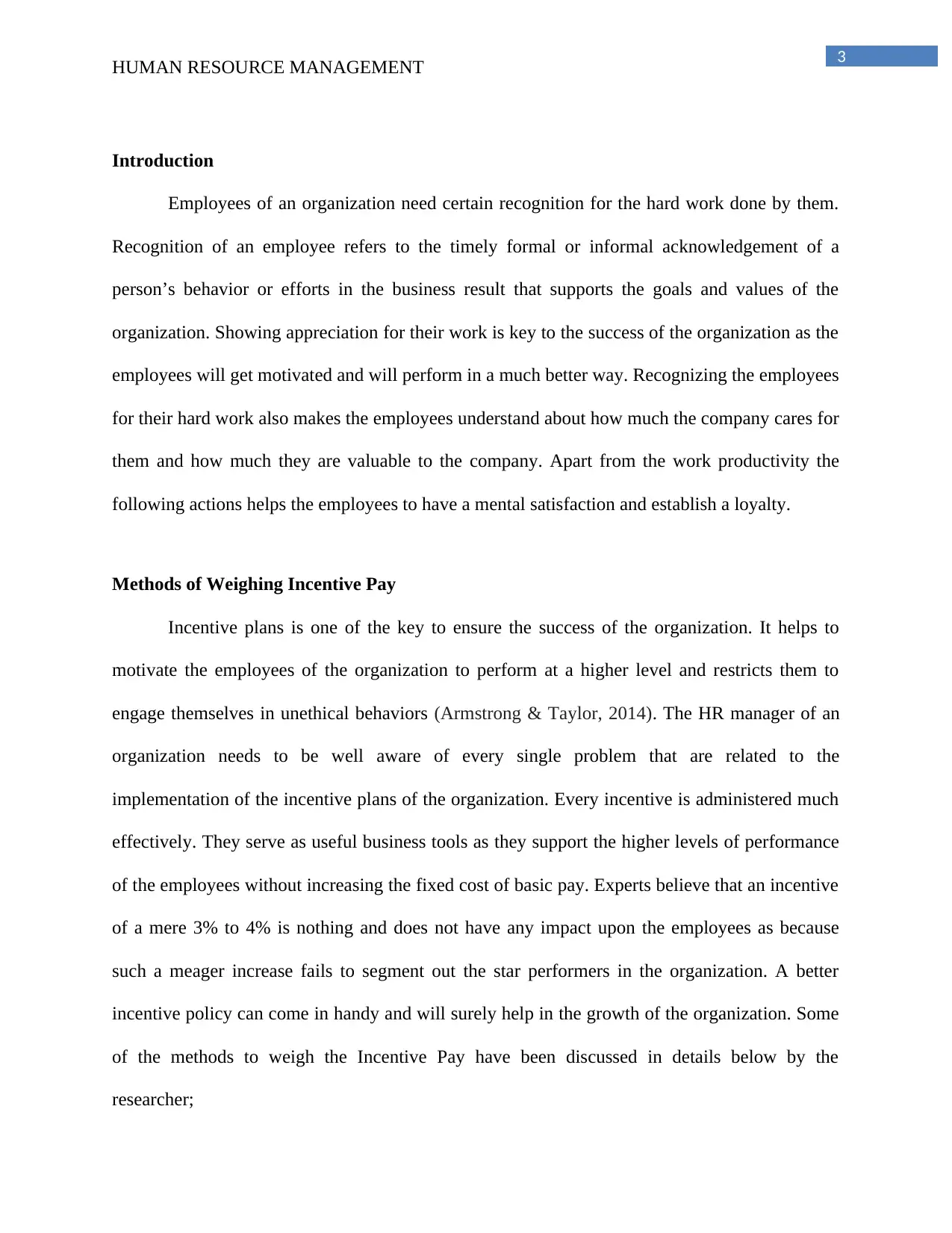
3
HUMAN RESOURCE MANAGEMENT
Introduction
Employees of an organization need certain recognition for the hard work done by them.
Recognition of an employee refers to the timely formal or informal acknowledgement of a
person’s behavior or efforts in the business result that supports the goals and values of the
organization. Showing appreciation for their work is key to the success of the organization as the
employees will get motivated and will perform in a much better way. Recognizing the employees
for their hard work also makes the employees understand about how much the company cares for
them and how much they are valuable to the company. Apart from the work productivity the
following actions helps the employees to have a mental satisfaction and establish a loyalty.
Methods of Weighing Incentive Pay
Incentive plans is one of the key to ensure the success of the organization. It helps to
motivate the employees of the organization to perform at a higher level and restricts them to
engage themselves in unethical behaviors (Armstrong & Taylor, 2014). The HR manager of an
organization needs to be well aware of every single problem that are related to the
implementation of the incentive plans of the organization. Every incentive is administered much
effectively. They serve as useful business tools as they support the higher levels of performance
of the employees without increasing the fixed cost of basic pay. Experts believe that an incentive
of a mere 3% to 4% is nothing and does not have any impact upon the employees as because
such a meager increase fails to segment out the star performers in the organization. A better
incentive policy can come in handy and will surely help in the growth of the organization. Some
of the methods to weigh the Incentive Pay have been discussed in details below by the
researcher;
HUMAN RESOURCE MANAGEMENT
Introduction
Employees of an organization need certain recognition for the hard work done by them.
Recognition of an employee refers to the timely formal or informal acknowledgement of a
person’s behavior or efforts in the business result that supports the goals and values of the
organization. Showing appreciation for their work is key to the success of the organization as the
employees will get motivated and will perform in a much better way. Recognizing the employees
for their hard work also makes the employees understand about how much the company cares for
them and how much they are valuable to the company. Apart from the work productivity the
following actions helps the employees to have a mental satisfaction and establish a loyalty.
Methods of Weighing Incentive Pay
Incentive plans is one of the key to ensure the success of the organization. It helps to
motivate the employees of the organization to perform at a higher level and restricts them to
engage themselves in unethical behaviors (Armstrong & Taylor, 2014). The HR manager of an
organization needs to be well aware of every single problem that are related to the
implementation of the incentive plans of the organization. Every incentive is administered much
effectively. They serve as useful business tools as they support the higher levels of performance
of the employees without increasing the fixed cost of basic pay. Experts believe that an incentive
of a mere 3% to 4% is nothing and does not have any impact upon the employees as because
such a meager increase fails to segment out the star performers in the organization. A better
incentive policy can come in handy and will surely help in the growth of the organization. Some
of the methods to weigh the Incentive Pay have been discussed in details below by the
researcher;
⊘ This is a preview!⊘
Do you want full access?
Subscribe today to unlock all pages.

Trusted by 1+ million students worldwide
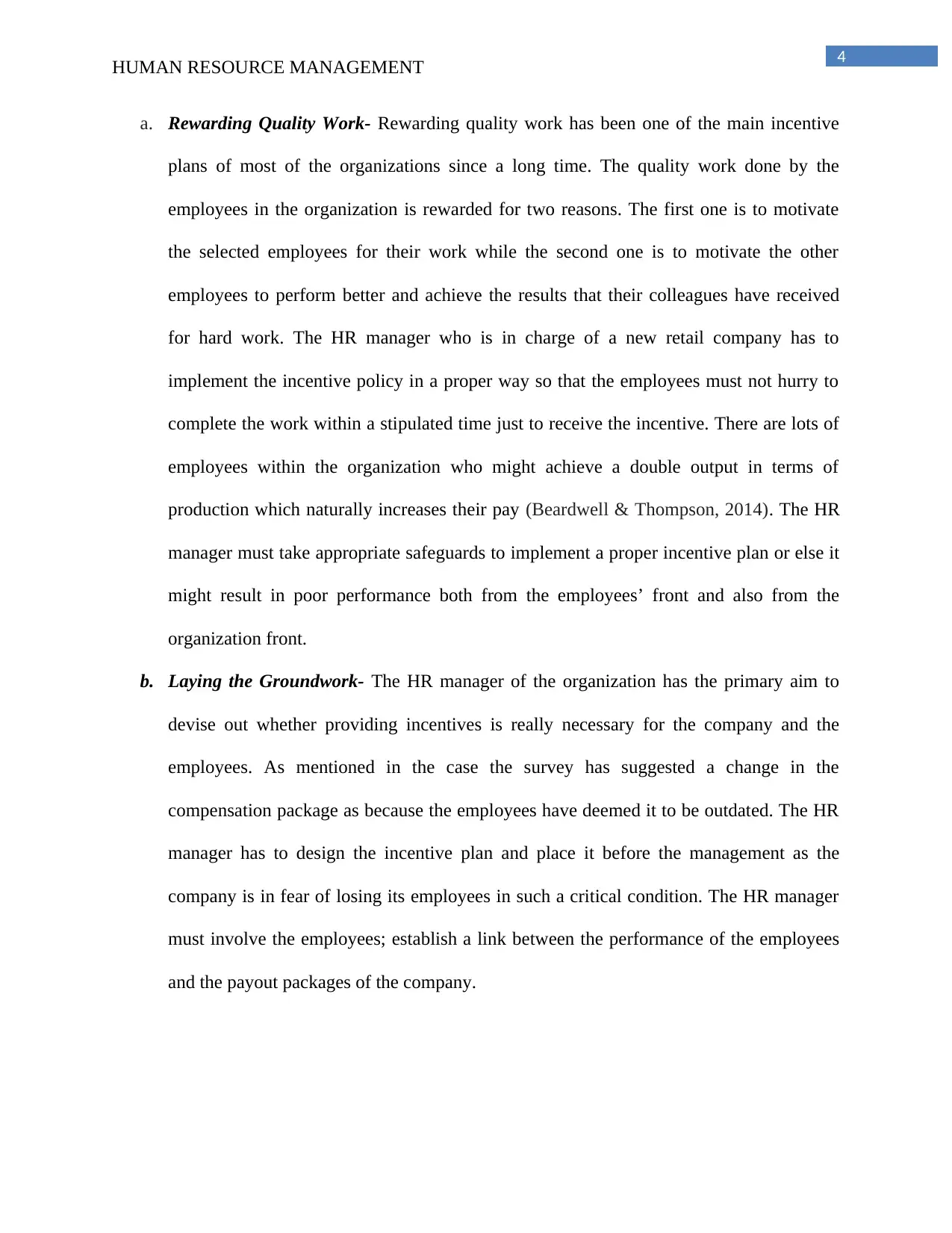
4
HUMAN RESOURCE MANAGEMENT
a. Rewarding Quality Work- Rewarding quality work has been one of the main incentive
plans of most of the organizations since a long time. The quality work done by the
employees in the organization is rewarded for two reasons. The first one is to motivate
the selected employees for their work while the second one is to motivate the other
employees to perform better and achieve the results that their colleagues have received
for hard work. The HR manager who is in charge of a new retail company has to
implement the incentive policy in a proper way so that the employees must not hurry to
complete the work within a stipulated time just to receive the incentive. There are lots of
employees within the organization who might achieve a double output in terms of
production which naturally increases their pay (Beardwell & Thompson, 2014). The HR
manager must take appropriate safeguards to implement a proper incentive plan or else it
might result in poor performance both from the employees’ front and also from the
organization front.
b. Laying the Groundwork- The HR manager of the organization has the primary aim to
devise out whether providing incentives is really necessary for the company and the
employees. As mentioned in the case the survey has suggested a change in the
compensation package as because the employees have deemed it to be outdated. The HR
manager has to design the incentive plan and place it before the management as the
company is in fear of losing its employees in such a critical condition. The HR manager
must involve the employees; establish a link between the performance of the employees
and the payout packages of the company.
HUMAN RESOURCE MANAGEMENT
a. Rewarding Quality Work- Rewarding quality work has been one of the main incentive
plans of most of the organizations since a long time. The quality work done by the
employees in the organization is rewarded for two reasons. The first one is to motivate
the selected employees for their work while the second one is to motivate the other
employees to perform better and achieve the results that their colleagues have received
for hard work. The HR manager who is in charge of a new retail company has to
implement the incentive policy in a proper way so that the employees must not hurry to
complete the work within a stipulated time just to receive the incentive. There are lots of
employees within the organization who might achieve a double output in terms of
production which naturally increases their pay (Beardwell & Thompson, 2014). The HR
manager must take appropriate safeguards to implement a proper incentive plan or else it
might result in poor performance both from the employees’ front and also from the
organization front.
b. Laying the Groundwork- The HR manager of the organization has the primary aim to
devise out whether providing incentives is really necessary for the company and the
employees. As mentioned in the case the survey has suggested a change in the
compensation package as because the employees have deemed it to be outdated. The HR
manager has to design the incentive plan and place it before the management as the
company is in fear of losing its employees in such a critical condition. The HR manager
must involve the employees; establish a link between the performance of the employees
and the payout packages of the company.
Paraphrase This Document
Need a fresh take? Get an instant paraphrase of this document with our AI Paraphraser
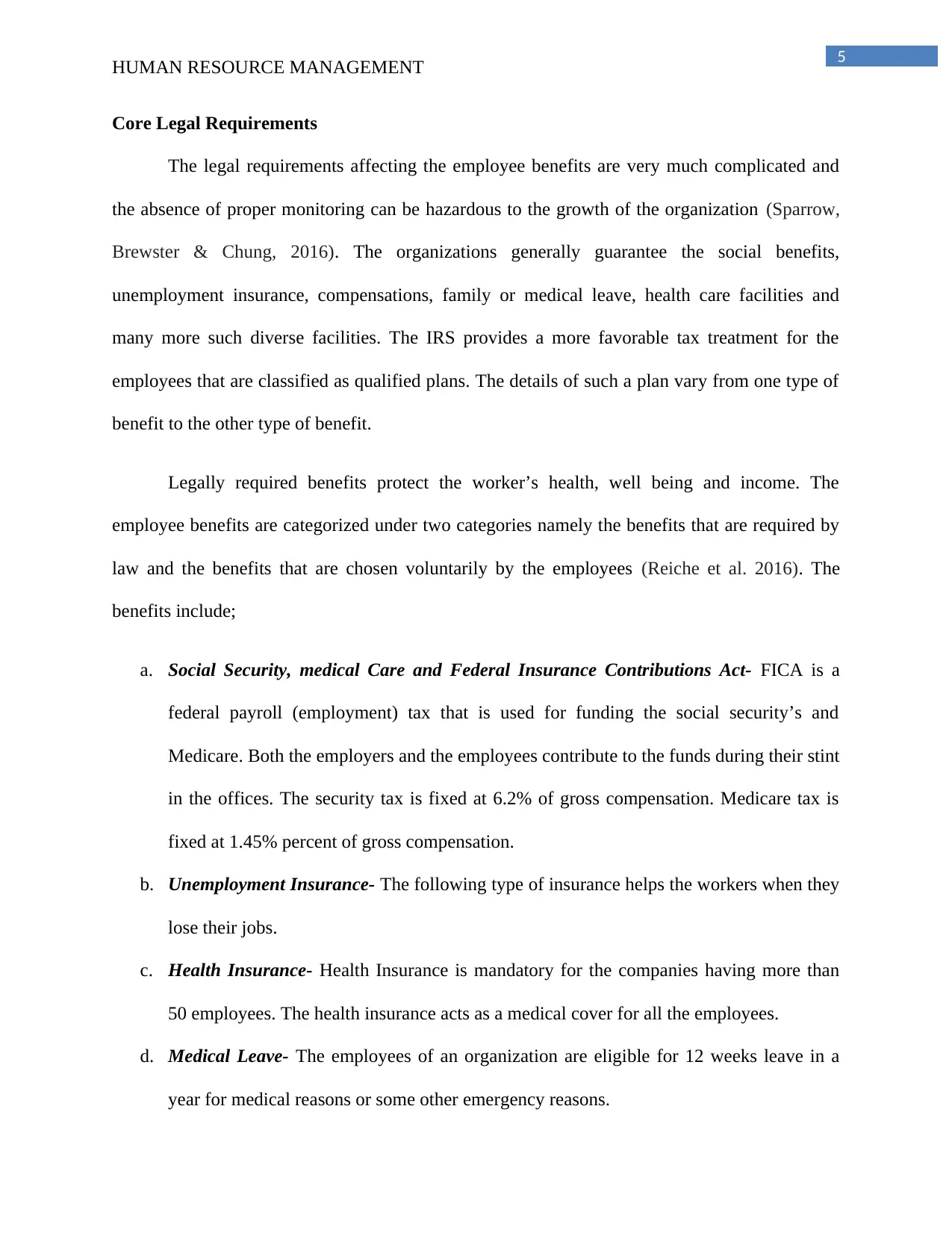
5
HUMAN RESOURCE MANAGEMENT
Core Legal Requirements
The legal requirements affecting the employee benefits are very much complicated and
the absence of proper monitoring can be hazardous to the growth of the organization (Sparrow,
Brewster & Chung, 2016). The organizations generally guarantee the social benefits,
unemployment insurance, compensations, family or medical leave, health care facilities and
many more such diverse facilities. The IRS provides a more favorable tax treatment for the
employees that are classified as qualified plans. The details of such a plan vary from one type of
benefit to the other type of benefit.
Legally required benefits protect the worker’s health, well being and income. The
employee benefits are categorized under two categories namely the benefits that are required by
law and the benefits that are chosen voluntarily by the employees (Reiche et al. 2016). The
benefits include;
a. Social Security, medical Care and Federal Insurance Contributions Act- FICA is a
federal payroll (employment) tax that is used for funding the social security’s and
Medicare. Both the employers and the employees contribute to the funds during their stint
in the offices. The security tax is fixed at 6.2% of gross compensation. Medicare tax is
fixed at 1.45% percent of gross compensation.
b. Unemployment Insurance- The following type of insurance helps the workers when they
lose their jobs.
c. Health Insurance- Health Insurance is mandatory for the companies having more than
50 employees. The health insurance acts as a medical cover for all the employees.
d. Medical Leave- The employees of an organization are eligible for 12 weeks leave in a
year for medical reasons or some other emergency reasons.
HUMAN RESOURCE MANAGEMENT
Core Legal Requirements
The legal requirements affecting the employee benefits are very much complicated and
the absence of proper monitoring can be hazardous to the growth of the organization (Sparrow,
Brewster & Chung, 2016). The organizations generally guarantee the social benefits,
unemployment insurance, compensations, family or medical leave, health care facilities and
many more such diverse facilities. The IRS provides a more favorable tax treatment for the
employees that are classified as qualified plans. The details of such a plan vary from one type of
benefit to the other type of benefit.
Legally required benefits protect the worker’s health, well being and income. The
employee benefits are categorized under two categories namely the benefits that are required by
law and the benefits that are chosen voluntarily by the employees (Reiche et al. 2016). The
benefits include;
a. Social Security, medical Care and Federal Insurance Contributions Act- FICA is a
federal payroll (employment) tax that is used for funding the social security’s and
Medicare. Both the employers and the employees contribute to the funds during their stint
in the offices. The security tax is fixed at 6.2% of gross compensation. Medicare tax is
fixed at 1.45% percent of gross compensation.
b. Unemployment Insurance- The following type of insurance helps the workers when they
lose their jobs.
c. Health Insurance- Health Insurance is mandatory for the companies having more than
50 employees. The health insurance acts as a medical cover for all the employees.
d. Medical Leave- The employees of an organization are eligible for 12 weeks leave in a
year for medical reasons or some other emergency reasons.
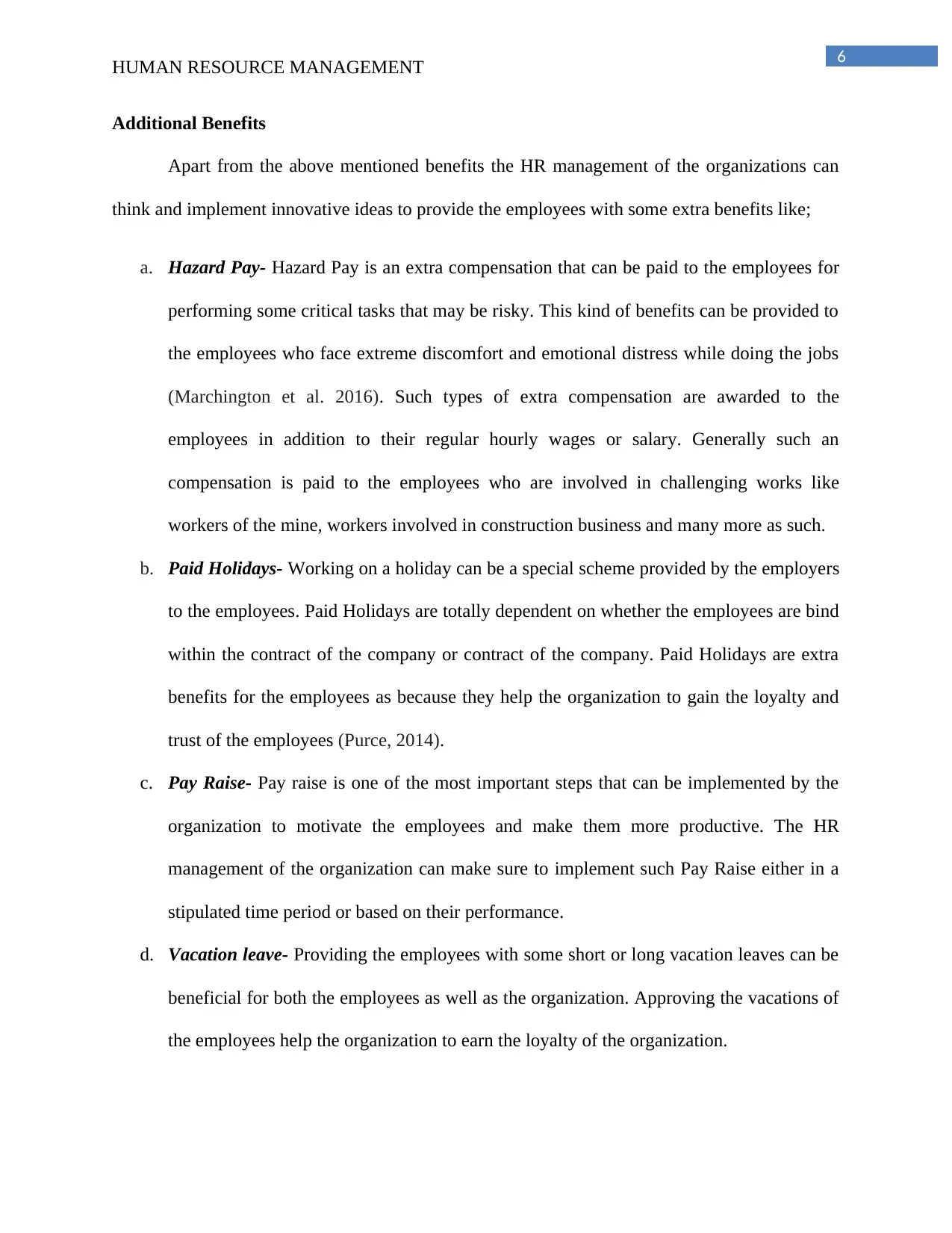
6
HUMAN RESOURCE MANAGEMENT
Additional Benefits
Apart from the above mentioned benefits the HR management of the organizations can
think and implement innovative ideas to provide the employees with some extra benefits like;
a. Hazard Pay- Hazard Pay is an extra compensation that can be paid to the employees for
performing some critical tasks that may be risky. This kind of benefits can be provided to
the employees who face extreme discomfort and emotional distress while doing the jobs
(Marchington et al. 2016). Such types of extra compensation are awarded to the
employees in addition to their regular hourly wages or salary. Generally such an
compensation is paid to the employees who are involved in challenging works like
workers of the mine, workers involved in construction business and many more as such.
b. Paid Holidays- Working on a holiday can be a special scheme provided by the employers
to the employees. Paid Holidays are totally dependent on whether the employees are bind
within the contract of the company or contract of the company. Paid Holidays are extra
benefits for the employees as because they help the organization to gain the loyalty and
trust of the employees (Purce, 2014).
c. Pay Raise- Pay raise is one of the most important steps that can be implemented by the
organization to motivate the employees and make them more productive. The HR
management of the organization can make sure to implement such Pay Raise either in a
stipulated time period or based on their performance.
d. Vacation leave- Providing the employees with some short or long vacation leaves can be
beneficial for both the employees as well as the organization. Approving the vacations of
the employees help the organization to earn the loyalty of the organization.
HUMAN RESOURCE MANAGEMENT
Additional Benefits
Apart from the above mentioned benefits the HR management of the organizations can
think and implement innovative ideas to provide the employees with some extra benefits like;
a. Hazard Pay- Hazard Pay is an extra compensation that can be paid to the employees for
performing some critical tasks that may be risky. This kind of benefits can be provided to
the employees who face extreme discomfort and emotional distress while doing the jobs
(Marchington et al. 2016). Such types of extra compensation are awarded to the
employees in addition to their regular hourly wages or salary. Generally such an
compensation is paid to the employees who are involved in challenging works like
workers of the mine, workers involved in construction business and many more as such.
b. Paid Holidays- Working on a holiday can be a special scheme provided by the employers
to the employees. Paid Holidays are totally dependent on whether the employees are bind
within the contract of the company or contract of the company. Paid Holidays are extra
benefits for the employees as because they help the organization to gain the loyalty and
trust of the employees (Purce, 2014).
c. Pay Raise- Pay raise is one of the most important steps that can be implemented by the
organization to motivate the employees and make them more productive. The HR
management of the organization can make sure to implement such Pay Raise either in a
stipulated time period or based on their performance.
d. Vacation leave- Providing the employees with some short or long vacation leaves can be
beneficial for both the employees as well as the organization. Approving the vacations of
the employees help the organization to earn the loyalty of the organization.
⊘ This is a preview!⊘
Do you want full access?
Subscribe today to unlock all pages.

Trusted by 1+ million students worldwide
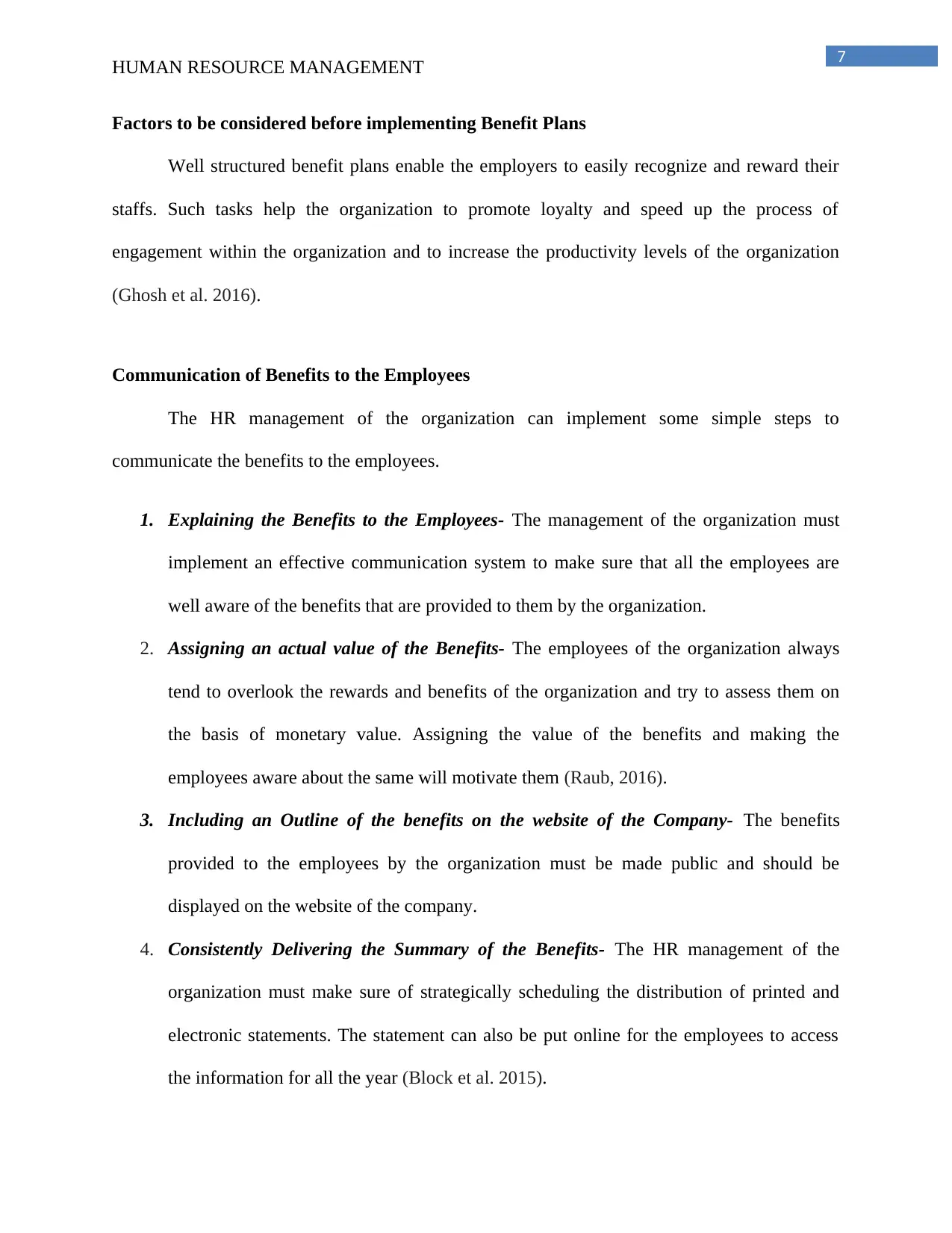
7
HUMAN RESOURCE MANAGEMENT
Factors to be considered before implementing Benefit Plans
Well structured benefit plans enable the employers to easily recognize and reward their
staffs. Such tasks help the organization to promote loyalty and speed up the process of
engagement within the organization and to increase the productivity levels of the organization
(Ghosh et al. 2016).
Communication of Benefits to the Employees
The HR management of the organization can implement some simple steps to
communicate the benefits to the employees.
1. Explaining the Benefits to the Employees- The management of the organization must
implement an effective communication system to make sure that all the employees are
well aware of the benefits that are provided to them by the organization.
2. Assigning an actual value of the Benefits- The employees of the organization always
tend to overlook the rewards and benefits of the organization and try to assess them on
the basis of monetary value. Assigning the value of the benefits and making the
employees aware about the same will motivate them (Raub, 2016).
3. Including an Outline of the benefits on the website of the Company- The benefits
provided to the employees by the organization must be made public and should be
displayed on the website of the company.
4. Consistently Delivering the Summary of the Benefits- The HR management of the
organization must make sure of strategically scheduling the distribution of printed and
electronic statements. The statement can also be put online for the employees to access
the information for all the year (Block et al. 2015).
HUMAN RESOURCE MANAGEMENT
Factors to be considered before implementing Benefit Plans
Well structured benefit plans enable the employers to easily recognize and reward their
staffs. Such tasks help the organization to promote loyalty and speed up the process of
engagement within the organization and to increase the productivity levels of the organization
(Ghosh et al. 2016).
Communication of Benefits to the Employees
The HR management of the organization can implement some simple steps to
communicate the benefits to the employees.
1. Explaining the Benefits to the Employees- The management of the organization must
implement an effective communication system to make sure that all the employees are
well aware of the benefits that are provided to them by the organization.
2. Assigning an actual value of the Benefits- The employees of the organization always
tend to overlook the rewards and benefits of the organization and try to assess them on
the basis of monetary value. Assigning the value of the benefits and making the
employees aware about the same will motivate them (Raub, 2016).
3. Including an Outline of the benefits on the website of the Company- The benefits
provided to the employees by the organization must be made public and should be
displayed on the website of the company.
4. Consistently Delivering the Summary of the Benefits- The HR management of the
organization must make sure of strategically scheduling the distribution of printed and
electronic statements. The statement can also be put online for the employees to access
the information for all the year (Block et al. 2015).
Paraphrase This Document
Need a fresh take? Get an instant paraphrase of this document with our AI Paraphraser
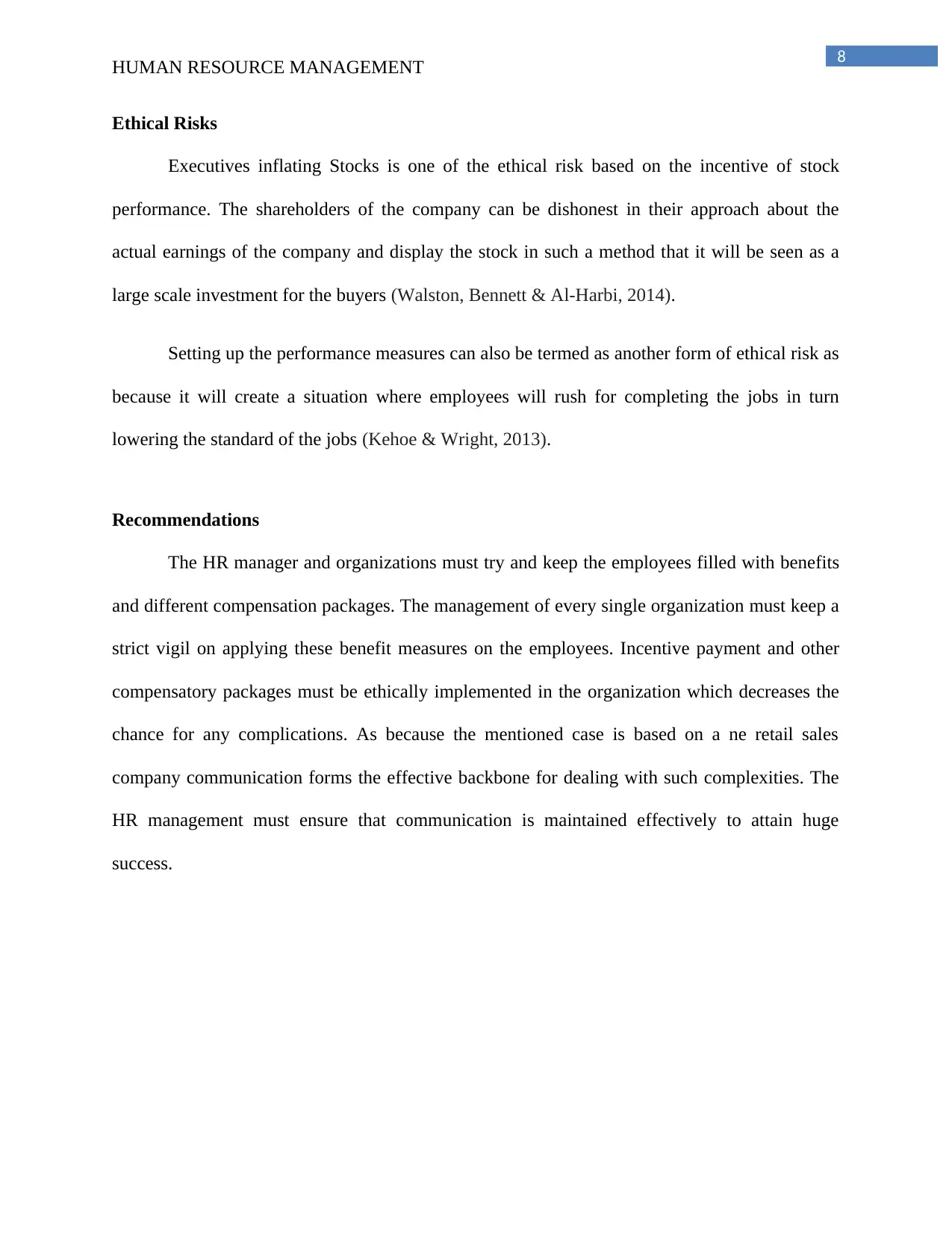
8
HUMAN RESOURCE MANAGEMENT
Ethical Risks
Executives inflating Stocks is one of the ethical risk based on the incentive of stock
performance. The shareholders of the company can be dishonest in their approach about the
actual earnings of the company and display the stock in such a method that it will be seen as a
large scale investment for the buyers (Walston, Bennett & Al-Harbi, 2014).
Setting up the performance measures can also be termed as another form of ethical risk as
because it will create a situation where employees will rush for completing the jobs in turn
lowering the standard of the jobs (Kehoe & Wright, 2013).
Recommendations
The HR manager and organizations must try and keep the employees filled with benefits
and different compensation packages. The management of every single organization must keep a
strict vigil on applying these benefit measures on the employees. Incentive payment and other
compensatory packages must be ethically implemented in the organization which decreases the
chance for any complications. As because the mentioned case is based on a ne retail sales
company communication forms the effective backbone for dealing with such complexities. The
HR management must ensure that communication is maintained effectively to attain huge
success.
HUMAN RESOURCE MANAGEMENT
Ethical Risks
Executives inflating Stocks is one of the ethical risk based on the incentive of stock
performance. The shareholders of the company can be dishonest in their approach about the
actual earnings of the company and display the stock in such a method that it will be seen as a
large scale investment for the buyers (Walston, Bennett & Al-Harbi, 2014).
Setting up the performance measures can also be termed as another form of ethical risk as
because it will create a situation where employees will rush for completing the jobs in turn
lowering the standard of the jobs (Kehoe & Wright, 2013).
Recommendations
The HR manager and organizations must try and keep the employees filled with benefits
and different compensation packages. The management of every single organization must keep a
strict vigil on applying these benefit measures on the employees. Incentive payment and other
compensatory packages must be ethically implemented in the organization which decreases the
chance for any complications. As because the mentioned case is based on a ne retail sales
company communication forms the effective backbone for dealing with such complexities. The
HR management must ensure that communication is maintained effectively to attain huge
success.
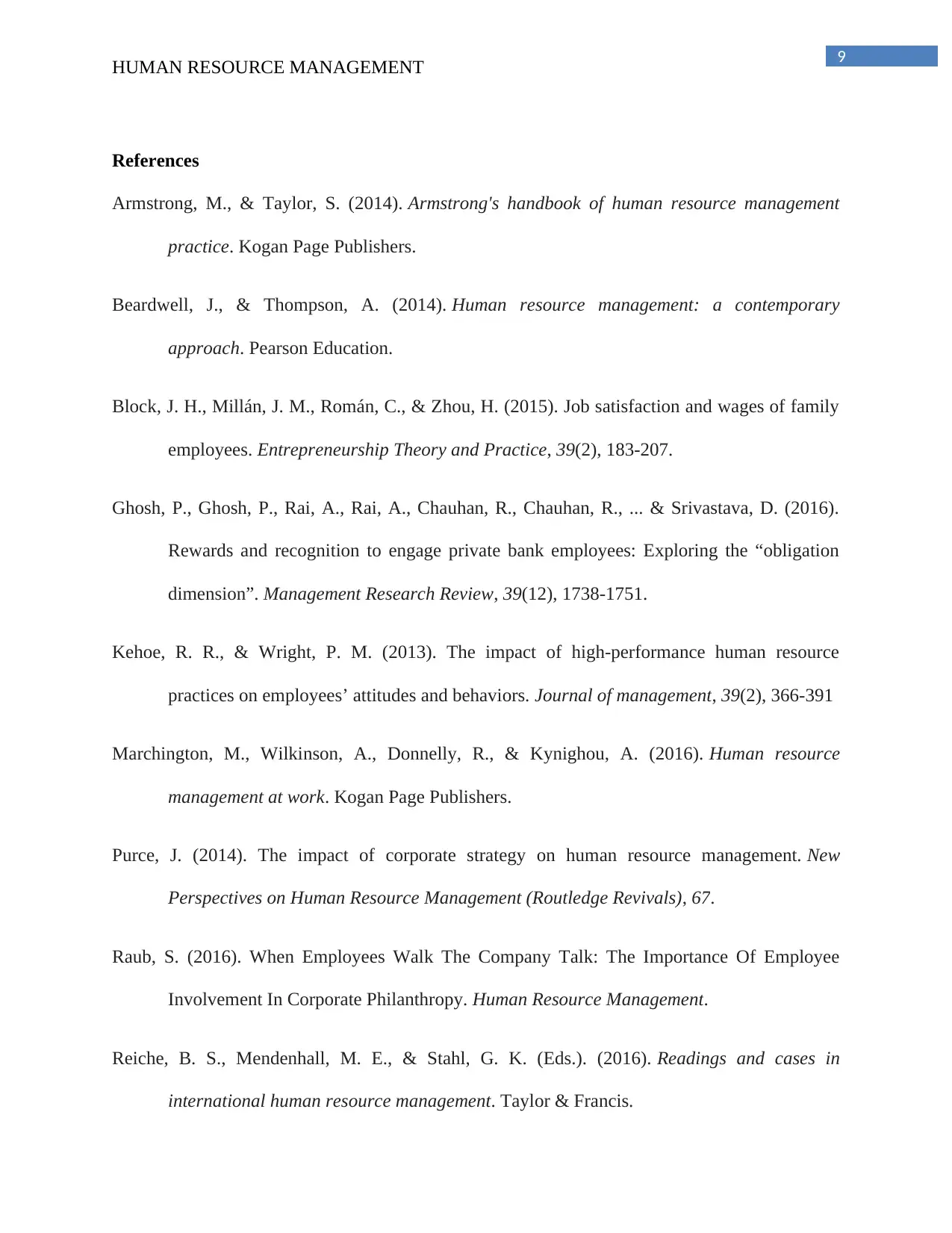
9
HUMAN RESOURCE MANAGEMENT
References
Armstrong, M., & Taylor, S. (2014). Armstrong's handbook of human resource management
practice. Kogan Page Publishers.
Beardwell, J., & Thompson, A. (2014). Human resource management: a contemporary
approach. Pearson Education.
Block, J. H., Millán, J. M., Román, C., & Zhou, H. (2015). Job satisfaction and wages of family
employees. Entrepreneurship Theory and Practice, 39(2), 183-207.
Ghosh, P., Ghosh, P., Rai, A., Rai, A., Chauhan, R., Chauhan, R., ... & Srivastava, D. (2016).
Rewards and recognition to engage private bank employees: Exploring the “obligation
dimension”. Management Research Review, 39(12), 1738-1751.
Kehoe, R. R., & Wright, P. M. (2013). The impact of high-performance human resource
practices on employees’ attitudes and behaviors. Journal of management, 39(2), 366-391
Marchington, M., Wilkinson, A., Donnelly, R., & Kynighou, A. (2016). Human resource
management at work. Kogan Page Publishers.
Purce, J. (2014). The impact of corporate strategy on human resource management. New
Perspectives on Human Resource Management (Routledge Revivals), 67.
Raub, S. (2016). When Employees Walk The Company Talk: The Importance Of Employee
Involvement In Corporate Philanthropy. Human Resource Management.
Reiche, B. S., Mendenhall, M. E., & Stahl, G. K. (Eds.). (2016). Readings and cases in
international human resource management. Taylor & Francis.
HUMAN RESOURCE MANAGEMENT
References
Armstrong, M., & Taylor, S. (2014). Armstrong's handbook of human resource management
practice. Kogan Page Publishers.
Beardwell, J., & Thompson, A. (2014). Human resource management: a contemporary
approach. Pearson Education.
Block, J. H., Millán, J. M., Román, C., & Zhou, H. (2015). Job satisfaction and wages of family
employees. Entrepreneurship Theory and Practice, 39(2), 183-207.
Ghosh, P., Ghosh, P., Rai, A., Rai, A., Chauhan, R., Chauhan, R., ... & Srivastava, D. (2016).
Rewards and recognition to engage private bank employees: Exploring the “obligation
dimension”. Management Research Review, 39(12), 1738-1751.
Kehoe, R. R., & Wright, P. M. (2013). The impact of high-performance human resource
practices on employees’ attitudes and behaviors. Journal of management, 39(2), 366-391
Marchington, M., Wilkinson, A., Donnelly, R., & Kynighou, A. (2016). Human resource
management at work. Kogan Page Publishers.
Purce, J. (2014). The impact of corporate strategy on human resource management. New
Perspectives on Human Resource Management (Routledge Revivals), 67.
Raub, S. (2016). When Employees Walk The Company Talk: The Importance Of Employee
Involvement In Corporate Philanthropy. Human Resource Management.
Reiche, B. S., Mendenhall, M. E., & Stahl, G. K. (Eds.). (2016). Readings and cases in
international human resource management. Taylor & Francis.
⊘ This is a preview!⊘
Do you want full access?
Subscribe today to unlock all pages.

Trusted by 1+ million students worldwide
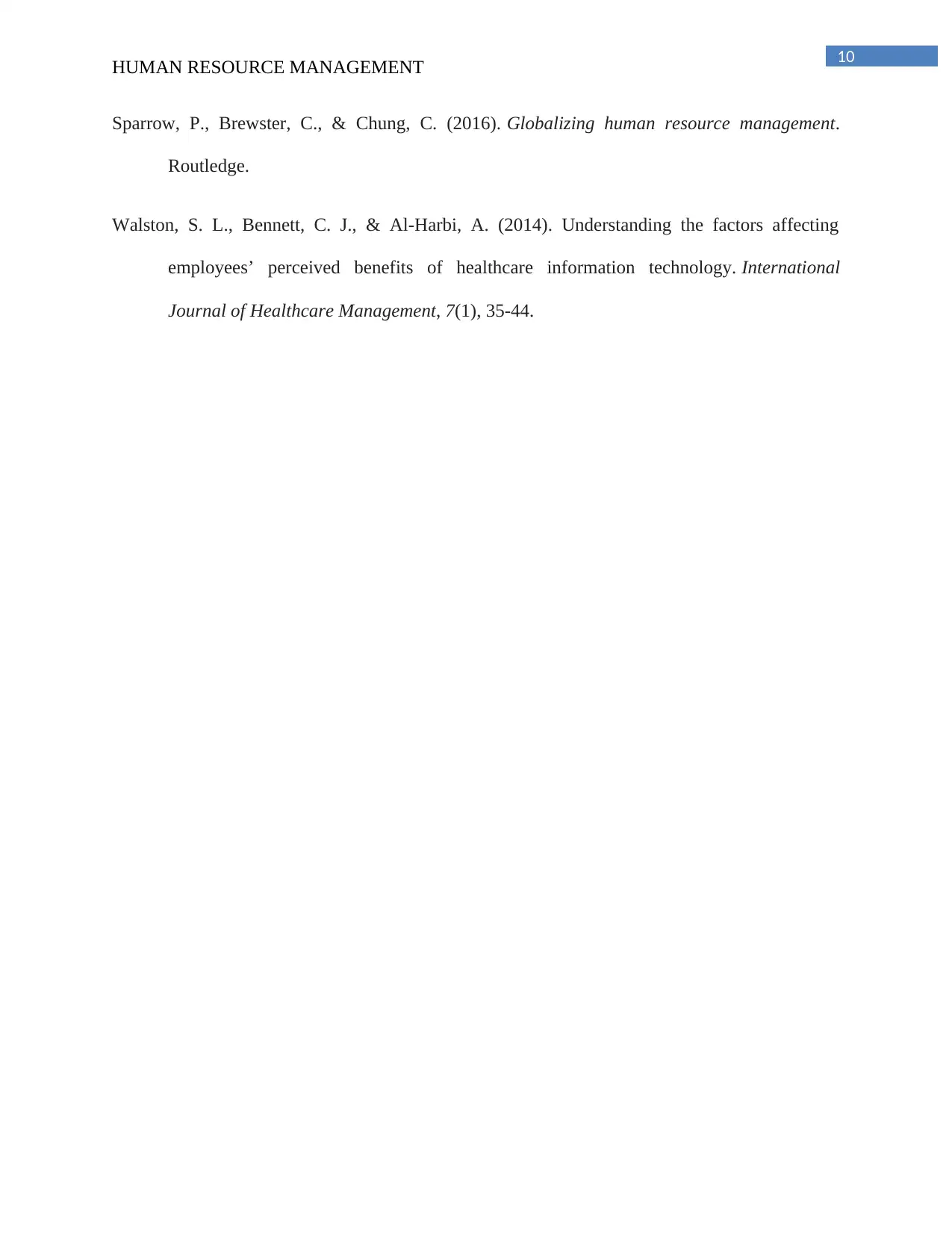
10
HUMAN RESOURCE MANAGEMENT
Sparrow, P., Brewster, C., & Chung, C. (2016). Globalizing human resource management.
Routledge.
Walston, S. L., Bennett, C. J., & Al-Harbi, A. (2014). Understanding the factors affecting
employees’ perceived benefits of healthcare information technology. International
Journal of Healthcare Management, 7(1), 35-44.
HUMAN RESOURCE MANAGEMENT
Sparrow, P., Brewster, C., & Chung, C. (2016). Globalizing human resource management.
Routledge.
Walston, S. L., Bennett, C. J., & Al-Harbi, A. (2014). Understanding the factors affecting
employees’ perceived benefits of healthcare information technology. International
Journal of Healthcare Management, 7(1), 35-44.
1 out of 10
Related Documents
Your All-in-One AI-Powered Toolkit for Academic Success.
+13062052269
info@desklib.com
Available 24*7 on WhatsApp / Email
![[object Object]](/_next/static/media/star-bottom.7253800d.svg)
Unlock your academic potential
Copyright © 2020–2025 A2Z Services. All Rights Reserved. Developed and managed by ZUCOL.





